Color Genesis of Brown Diamond from the Mengyin Kimberlite, China
Abstract
:1. Introduction
2. Materials and Methods
2.1. Materials
2.2. Methods
3. Results
3.1. Microscopic Magnification Examination
- (1)
- (2)
- The color is divergently distributed from core to rim. The brown color of MY-25 gradually becomes lighter from core to rim (Figure 1b).
- (3)
- (4)
- Brown is scattered in a circular zone. Sample MY-47 has an obvious brown color band, which is distributed in a ring shape. The brown band of the sample MY-47 is the darkest and becomes lighter from the center to both wings (Figure 1g). Black inclusions in the core rimmed changing colors from colorless to light brown in sample MY-30. Remarkably, the color near the rim displays as slightly darker, and shows transitional color from light brown to brown, and it is interspersed in a vague ring (Figure 1h). Abundant black inclusions and fractures associated with the brown zones are scattered in the whole slice sample DB5 (Figure 1i) (Table S1).
3.2. Properties of Orthogonal Polarization
- (1)
- Flat extinction strip
- (2)
- Radial extinction pattern
- (3)
- Fine lattice-like matte pattern (“tatami” in shape)
- (4)
- Cross extinction pattern
- (5)
- Bow-tie extinction pattern
- (6)
- Combined and superposing extinction pattern
3.3. Cathodoluminescence Features
3.4. Infrared Spectrum Features
3.5. Low-Temperature Photoluminescence Spectrum Features
3.6. Raman Spectral Features
3.7. Ultraviolet-Visible Absorption Spectrum Features
3.8. Transmission Electron Microscope Features
4. Discussion
4.1. Brown Color Related to Plastic Deformation
4.2. Brown Color Related to Non-Deformation
5. Conclusions
Supplementary Materials
Author Contributions
Funding
Acknowledgments
Conflicts of Interest
References
- Harris, J.W. Diamond. In Encyclopedia of Geology, 2nd ed.; Alderton, D., Elias, S.A., Eds.; Academic Press: Oxford, UK, 2021; pp. 455–472. [Google Scholar]
- Yin, X.-L. Genesis of diamond coloration. Superhard Mater Eng. 2007, 2, 53–56, (In Chinese with English Abstract). [Google Scholar]
- Laidlaw, F.H.J.; Diggle, P.L.; Breeze, B.G.; Dale, M.W.; Fisher, D.; Beanland, R. Spatial distribution of defects in a plastically deformed natural brown diamond. Diam. Relat. Mater. 2021, 117, 108465. [Google Scholar] [CrossRef]
- Hainschwang, T.; Notari, F.; Pamies, G. A Defect Study and Classification of Brown Diamonds with Non-Deformation-Related Color. Minerals 2020, 10, 914. [Google Scholar] [CrossRef]
- Hainschwang, T.; Notari, F.; Pamies, G. A Defect Study and Classification of Brown Diamonds with Deformation-Related Color. Minerals 2020, 10, 903. [Google Scholar] [CrossRef]
- Harris, J. Diamond Geology. In The Properties of Natural and Synthetic Diamonds; Academic Press: London, UK, 1992; pp. 345–393. [Google Scholar]
- Byrne, K.S.; Chapman, J.G.; Luiten, A.N. Photochromic charge transfer processes in natural pink and brown diamond. J. Phys. Condens. Matter 2014, 26, 35501. [Google Scholar] [CrossRef]
- Shigley, J.E.; Chapman, J.; Ellison, R.K. Discovery and mining of the argyle diamond deposit, Australia. Gems Gemol. 2001, 37, 26–41. [Google Scholar] [CrossRef]
- Collins, A.T.; Kanda, H.; Kitawaki, H. Color changes produced in natural brown diamonds by high-pressure, high-temperature treatment. Diam. Relat. Mater. 2000, 9, 113–122. [Google Scholar] [CrossRef]
- Tappert, R.; Tappert, M.C. Diamonds in Nature: A Guide to Rough Diamonds; Springer: Berlin, Germany, 2011. [Google Scholar]
- Orlov, Y.L. Diamond Mineralogy, 1st ed.; China Construction Industry Press: Beijing, China, 1977. [Google Scholar]
- Li, H.B. Study on Characters of Plastic Deformation in Brown Diamonds from Kimberlite Pipe Shengli No.1, Mengyin County, Shandong Province. Master’s Thesis, China University of Geosciences, Beijing, China, 2006. (In Chinese with English Abstract). [Google Scholar]
- Yang, M.X.; Pan, Z.L. Characters of Plastic Deformation on Diamond from Hunan Province, China. J. Gems Gemmol. 2004, 29, 45–49, (In Chinese with English Abstract). [Google Scholar]
- Lang, A.R. Causes of Birefringence in Diamond. Nature 1967, 213, 248–251. [Google Scholar] [CrossRef]
- Collins, A.T. The Defection of Color-Enhanced and Synthetic Gem Diamonds by Optical Spectroscopy. Diam. Relat. Mater. 2003, 12, 1976–1983. [Google Scholar] [CrossRef]
- Yu, X.Y.; Long, Z.Y.; Zhang, Y.; Qin, L.J.; Zhang, C.; Xie, Z.R.; Wu, Y.R.; Yan, Y.; Wu, M.K.; Wan, J.X. Overview of Gemstone Resources in China. Crystals 2021, 11, 1189. [Google Scholar] [CrossRef]
- Yin, G.H. Noble Gas and Internal Characters of Diamond from Mengyin Area, Shandong Province and the Geologic Genesis. Master’s Thesis, China University of Geosciences, Beijing, China, 2016. (In Chinese with English Abstract). [Google Scholar]
- Yang, Z.J.; Liang, R.; Zeng, X.Q.; Ge, T.Y.; Ai, Q.; Zheng, Y.L.; Peng, M.S. Study on the Micro-Infrared Spectra and Origin of Polycrystalline Diamonds from Mengyin Kimberlite Pipes. Spectrosc. Spectr. Anal. 2012, 32, 1512–1518, (In Chinese with English Abstract). [Google Scholar]
- Chen, M.H.; Chen, Z.; Di, J.R. Structure Defects in Type Ia Brown Diamonds by Polychromatic Synchrotron Radiation Topography. Earth Sci.—J. China Univ. Geosci. 2005, 30, 187–190, 194, (In Chinese with English Abstract). [Google Scholar]
- Yang, M.X.; Pan, Z.L. Heterogeneous Interior Characters of Diamond in Hunan. Geol. Sci. Technol. Inf. 2001, 20, 61–63, (In Chinese with English Abstract). [Google Scholar]
- Qi, L.J.; Yuan, X.Q.; Tian, L.G.; Yuan, Z.Z. Evolution and Colouration of Lattice Defects in Diamonds at High Pressure and High Temperature. J. Gems Gemmol. 2001, 3, 1–7, (In Chinese with English Abstract). [Google Scholar]
- Stepanov, A.S.; Korsakov, A.V.; Yuryeva, O.P.; Nadolinniy, V.A.; Perraki, M.; Gussem, K.D.; Vandenabeele, P. Brown diamonds from an eclogite xenolith from Udachnaya kimberlite, Yakutia, Russia. Spectrochim. Acta Part A 2011, 80, 41–48. [Google Scholar] [CrossRef]
- Shigley, J.E.; Fritsch, E. A notable red-brown diamond. J. Gemmol. 1993, 23, 259–266. [Google Scholar] [CrossRef]
- Gaillou, E.; Post, J.E.; Bassim, N.D.; Zaitsev, A.M.; Rose, T.; Fries, M.D.; Stroud, R.M.; Steele, A.; Butler, J.E. Spectroscopic and microscopic characterizations of color lamellae in natural pink diamonds. Diam. Relat. Mater. 2010, 19, 1207–1220. [Google Scholar] [CrossRef]
- Fisher, D. Brown diamonds and high pressure high temperature treatment. Lithos 2009, 112, 619–624. [Google Scholar] [CrossRef]
- Eaton-Magaña, S.; Ardon, T.; Smit, K.V.; Breeding, C.M.; Shigley, J.E. Natural-color pink, purple, red, and brown diamonds: Band of Many Colors. Gems Gemol. 2017, 54, 352–377. [Google Scholar]
- Howell, D.; Fisher, D.; Piazolo, S.; Grifin, W.L.; Sibley, S.J. Pink color in Type I diamonds: Is Deformation Twinning the Cause? Am. Mineral. 2015, 100, 1518–1527. [Google Scholar] [CrossRef]
- Schoor, M.; Boulliard, J.C.; Gaillou, E.; Hardouin Duparc, O.; Estève, I.; Baptiste, B.; Rondeau, B.; Fritsch, E. Plastic deformation in natural diamonds: Rose Channels Associated to Mechanical Twinning. Diam. Relat. Mater. 2016, 66, 102–106. [Google Scholar] [CrossRef]
- Deljanin, B.; Simic, D.; Zaitsev, A.M.; Chapman, J.; Dobrinets, I.; Widemann, A.; Del Re, N.; Middleton, T.; Deljanin, E.; De Stefano, A. Characterization of pink diamonds of different origin: Natural (Argyle, Non-Argyle), Irradiated and Annealed, Treated with Multi-Process, Coated and Synthetic. Diam. Relat. Mater. 2008, 17, 1169–1178. [Google Scholar] [CrossRef]
- Dobrinets, I.A.; Vins, V.G.; Zaitsev, A.M. HPHT-Treated Diamonds, 1st ed.; Springer: Berlin/Heidelberg, Germany, 2013. [Google Scholar] [CrossRef]
- Yang, M.X.; Gao, Y. Characters of Brown Spot on Diamond from Hunan Province and Its Implication. J. Gems Gemmol. 2002, 4, 15–19, (In Chinese with English Abstract). [Google Scholar]
- Peng, M.S.; Lin, B.; Peng, Z.L. A Preliminary Study on the Mechanism of Coloration of Fancy Diamond. Bull. Mineral. Petrol. Geochem. 1999, 18, 395–397, (In Chinese with English Abstract). [Google Scholar]
- Zhao, H.D. The Relationship between the Diamond’s Physical and Energy of Mineralization. Geol. Shandong 1996, 12, 50–56, (In Chinese with English Abstract). [Google Scholar]
- Lv, Q.; Liu, F.; Chu, Z.Y.; Ge, Y.J.; Liu, X.; Jiao, Y.X. The mineralogical characteristics and comparison of diamonds in the three kimberlite belts in Mengyin, Shandong Province. Acta Geol. Sin. 2021, 95. Available online: http://www.geojournals.cn/dzxb/ch/reader/download_new_edit_content.aspx?file_no=202102040000001&flag=2&journal_id=dzxb&year_id=0 (accessed on 29 December 2021). (In Chinese with English Abstract).
- Gu, T.; Wang, W. Optical defects in milky type IaB diamonds. Diam. Relat. Mater. 2018, 89, 322–329. [Google Scholar] [CrossRef]
- Bocharov, S.N.; Isakov, A.I.; Petrov, Y.Y.; Orekhova, K.N.; Dementeva, E.V.; Burakov, B.E.; Zamoryanskaya, M.V. Study of radioluminescence and cathodoluminescence of artificial diamond single crystals as prospective durable core material for nuclear electric batteries. Diam. Relat. Mater. 2021, 120, 108658. [Google Scholar] [CrossRef]
- Chen, M.H.; Di, J.R. Application of Cathodoluminescence and Ftir Analysis in Diamond Studies. Geol. Sci. Technol. Inf. 1999, 18, 97–100, (In Chinese with English Abstract). [Google Scholar]
- Hamers, R.J.; Stavis, C.; Pokhrel, A.; Franking, R.; Ruther, R.E.; Wang, X.; Cooperrider, M.C.; Zheng, H.; Carlisle, J.A.; Butler, J.E. Characterization of molecular and biomolecular layers on diamond thin films by infrared reflection–absorption spectroscopy. Diam. Relat. Mater. 2011, 20, 733–742. [Google Scholar] [CrossRef]
- Yuan, Z.Z.; Peng, M.S.; Meng, Y.F. Spectroscopic Studies on Irradiated Enhanced Fancy color Diamonds. J. Mineral. Petrol. 2005, 25, 47–51, (In Chinese with English Abstract). [Google Scholar]
- Yuan, Z.Z.; Peng, M.S.; Meng, Y.F. Spectroscopic Studies on Fancy color Diamonds. Acta Mineral. Sin. 2006, 26, 73–76, (In Chinese with English Abstract). [Google Scholar]
- He, X.M. Infrared Spectrum Characteristics and Classification of Nature Diamond. Geol. Explor. 2000, 36, 45–47, (In Chinese with English Abstract). [Google Scholar]
- Khachatryan, G.K.; Kaminsky, F.V. “Equilibrium” and “non-equilibrium” diamond crystals from deposits in the East European Platform, as revealed by infrared absorption data. Can. Mineral. 2003, 41, 171–184. [Google Scholar] [CrossRef] [Green Version]
- Boyd, S.R.; Kiflawi, I.; Woods, G.S. Infrared absorption by the B nitrogen aggregate in diamond. Philos. Mag. B 1995, 72, 351–361. [Google Scholar] [CrossRef]
- Speich, L.; Kohn, S.C. QUIDDIT—QUantification of infrared active Defects in Diamond and Inferred Temperatures. Comput Geosci. 2020, 144, 104558. [Google Scholar] [CrossRef]
- Boyd, S.R.; Kiflawi, I.; Woods, G.S. The relationship between infrared absorption and the A defect concentration in diamond, Physics of condensed matter. Structural, electronic, optical, and magnetic properties. Philos. Mag. B 1994, 69, 1149–1153. [Google Scholar] [CrossRef]
- Taylor, W.R.; Jaques, A.L.; Ridd, M. Nitrogen-defect aggregation characteristics of some Australasian diamonds; time-temperature constraints on the source regions of pipe and alluvial diamonds. Am. Mineral. 1990, 75, 1290–1310. [Google Scholar]
- Taylor, W.R.; Canil, D.; Judith Milledge, H. Kinetics of Ib to IaA nitrogen aggregation in diamond. Geochim. Cosmochim. Acta 1996, 60, 4725–4733. [Google Scholar] [CrossRef]
- Dong, B.; Shi, C.K.; Xu, Z.W.; Wang, K.Y.; Luo, H.H.; Sun, F.W.; Wang, P.F.; Wu, E.; Zhang, K.; Liu, J.Y.; et al. Temperature dependence of optical centers in Ib diamond characterized by photoluminescence spectra. Diam. Relat. Mater. 2021, 116, 108389. [Google Scholar] [CrossRef]
- Ferrari, A.C. Determination of bonding in diamond-like carbon by Raman spectroscopy. Diam. Relat. Mater. 2002, 11, 1053–1061. [Google Scholar] [CrossRef]
- Xue, L.H.; Yue, W.H.; Chen, F.; Deng, E.S. Study on Isomorphous Substitution and Vibrational Spectra in Diamonds. J. Wuhan Univ. Technol. 1999, 21, 1–4, (In Chinese with English Abstract). [Google Scholar]
- Meng, Y.F.; Peng, M.S. Study on defects and color mechanism of Brown Diamond. Proceedings of the 11th Annual Academic Conference of Chinese Society for Mineralogy. Petrol. Geochem. 2007, 123–124. Available online: https://cpfd.cnki.com.cn/Article/CPFDTOTAL-ZGKD200704001066.htm (accessed on 1 December 2021). (In Chinese).
- Collins, A.T. Spectroscopy of defects and transition metals in diamond. Gems Gemol. 2000, 9, 417–423. [Google Scholar] [CrossRef]
- Koivula, J.L.; Kammerling, R.C.; Fritsch, E. More on irradiated black diamonds. Gems Gemol. 1992, 28, 276. [Google Scholar]
- Meng, Y.F. Study on Defects and Coloration Mechanism of Brown Diamond. Ph.D. Thesis, Sun Yat-sen University, Guangzhou, China, 2006. (In Chinese with English Abstract). [Google Scholar]
- Yang, M.X. Study on Internal Characteristics and Brown Origin of Diamond in Hunan Province. Ph.D. Thesis, China University of Geosciences, Wuhan, China, 2000. (In Chinese with English Abstract). [Google Scholar]
- Wu, G.C.; Yu, X.Y. An analysis of the characteristics of brown diamonds from Mengyin in Shandong Province under transmission electron microscopy (TEM). Acta Petrol. Mineral. 2014, 33, 111–119, (In Chinese with English Abstract). [Google Scholar]
- Chinn, I.L.; Gurney, J.J.; Milledge, J.H.; Taylor, W.R.; Woods, P.A. Cathodoluminescence Properties of CO2-Bearing and CO2-Free Diamonds from the George Creek K1 Kimberlite Dike. Int. Geol. Rev. 1995, 37, 254–258. [Google Scholar] [CrossRef]
- Zheng, Y.; Li, C.; Liu, J.; Wei, J.; Ye, H. Diamond with nitrogen: States, Control, and Applications. Funct. Diam. 2022, 1, 63–82. [Google Scholar] [CrossRef]
- Ashfold, M.N.R.; Goss, J.P.; Green, B.L.; May, P.W.; Newton, M.E.; Peaker, C.V. Nitrogen in Diamond. Chem. Rev. 2020, 120, 5745–5794. [Google Scholar] [CrossRef]
- Yin, Z.W.; Lu, F.X.; Chen, M.H.; Xu, H.Y. Ages and environments of formation of diamonds in Mengyin County, Shandong Province. Earth Sci. Front. 2005, 4, 614–621, (In Chinese with English Abstract). [Google Scholar]
- Chen, Z. Study on Color Characteristics and Structural Defects of type Ia Brown Diamond. Master’s Thesis, China University of Geosciences, Wuhan, China, 2004. (In Chinese with English Abstract). [Google Scholar]
- Collins, A.T. Colour centers in diamond. J. Gemmol. 1982, 18, 37–75. [Google Scholar] [CrossRef]
- Kaminsky, F. Mineralogy of the lower mantle: A Review of ‘Super-Deep’ Mineral Inclusions in Diamond. Earth-Sci. Rev. 2012, 110, 127–147. [Google Scholar] [CrossRef]
- Wang, K.Y. Photoluminescence Studies of Optical Centres in Electron-Irradiated Diamond. Master’s Thesis, Tianjin University, Tianjing, China, 2012. (In Chinese with English Abstract). [Google Scholar]
- Goss, J.P.; Briddon, P.R.; Hill, V.; Jones, R.; Rayson, M.J. Identification of the structure of the 3107 cm−1 H-related defect in diamond. J. Phys. Condens. Matter 2014, 26, 145801. [Google Scholar] [CrossRef] [PubMed]
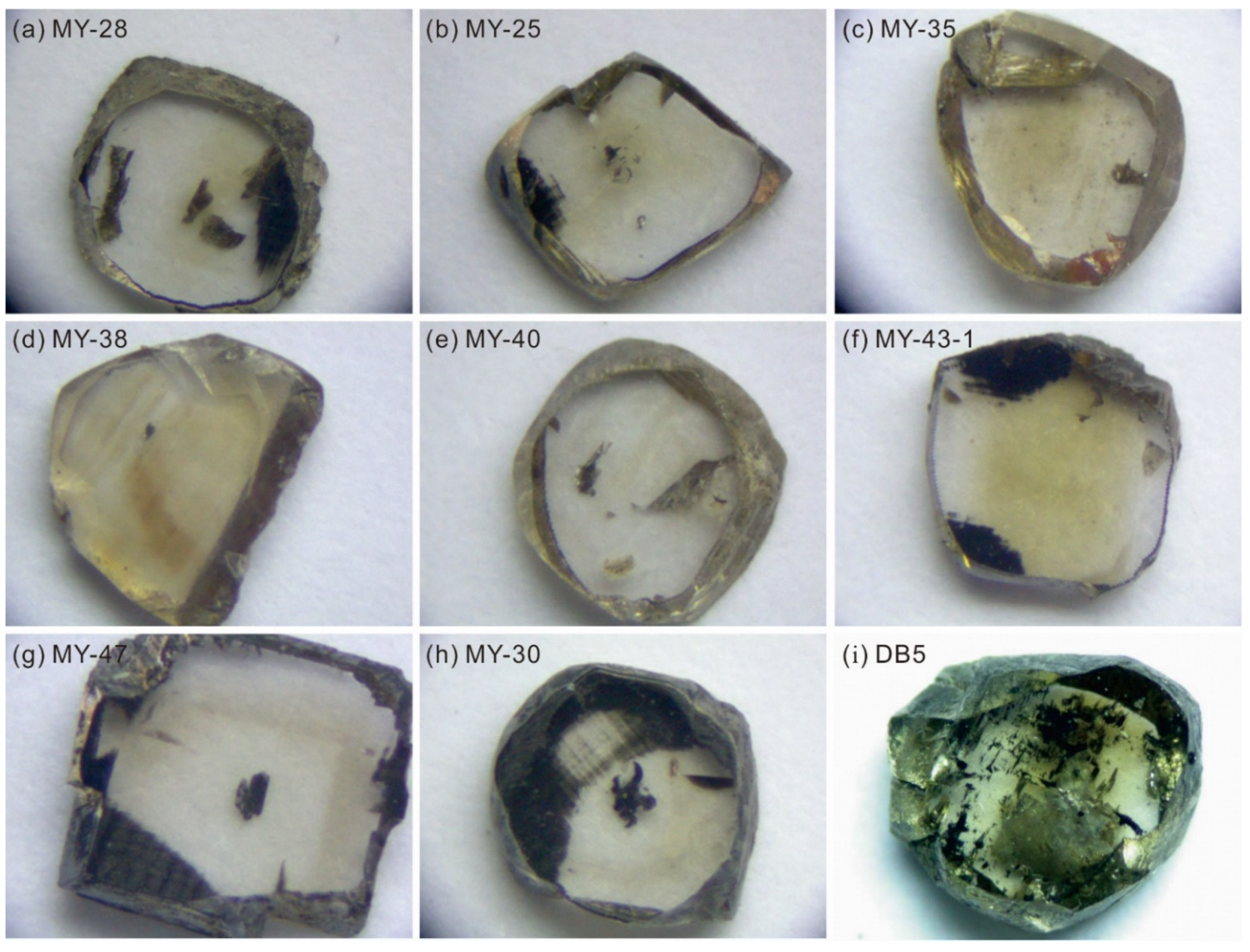
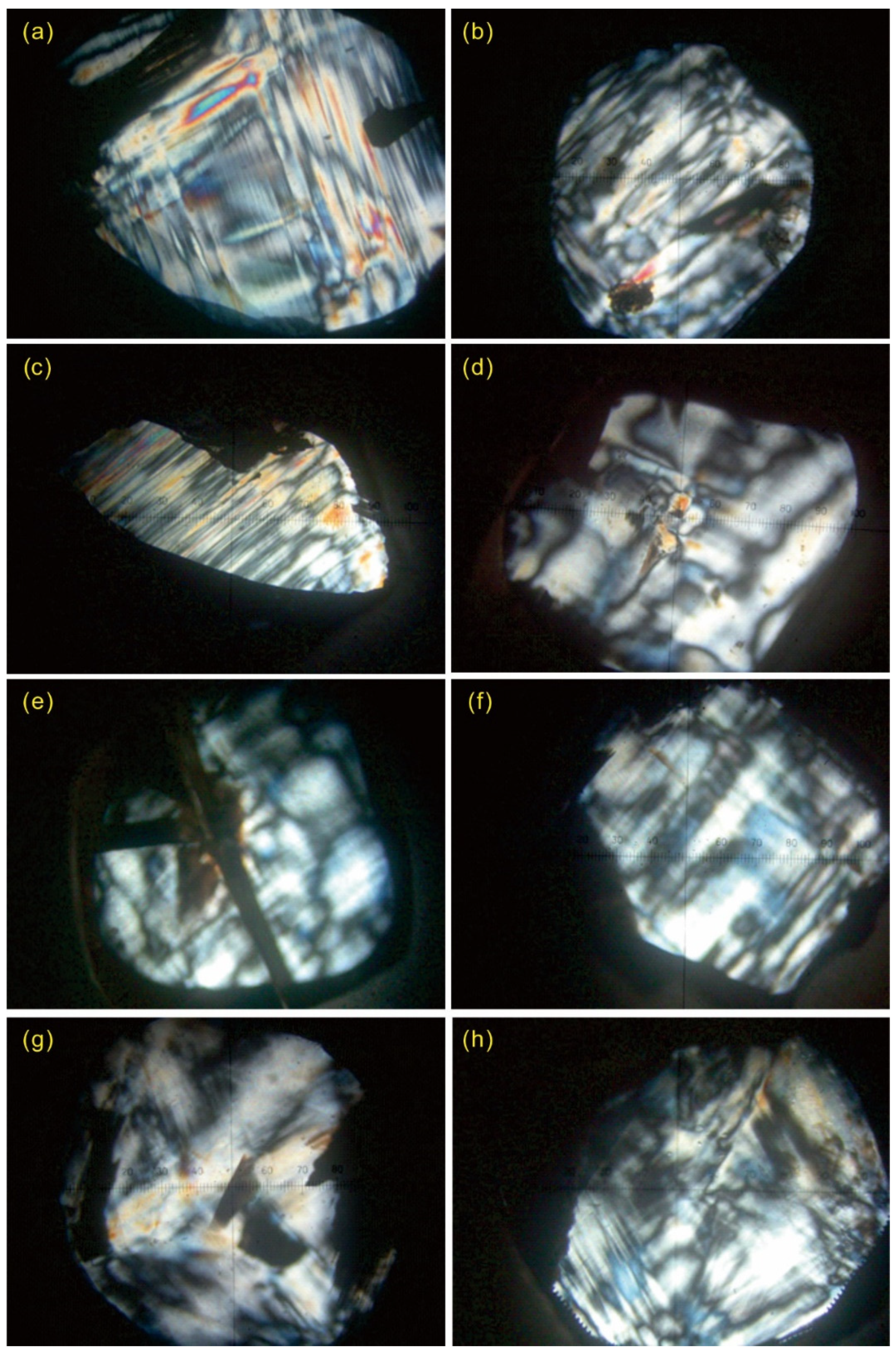


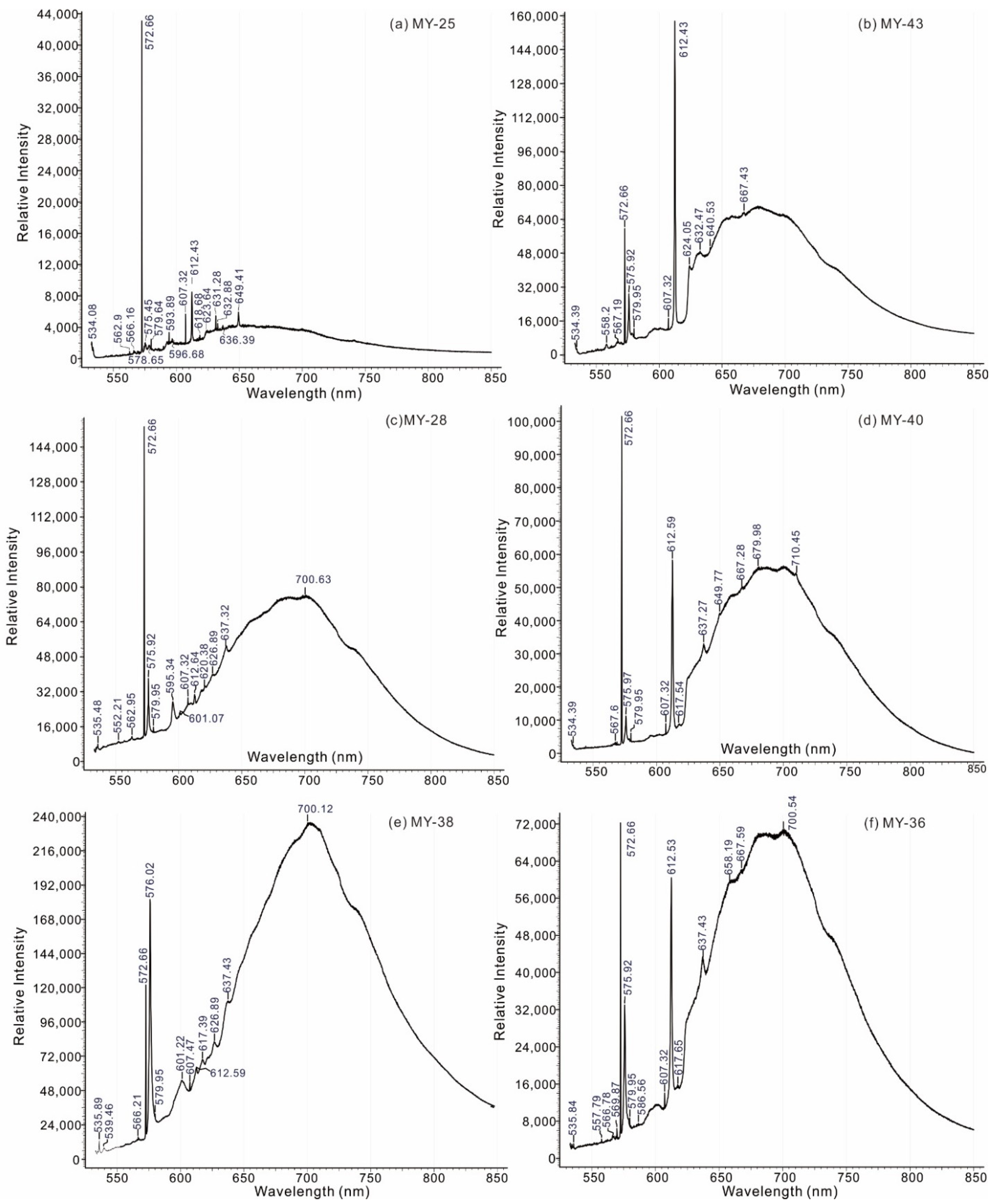
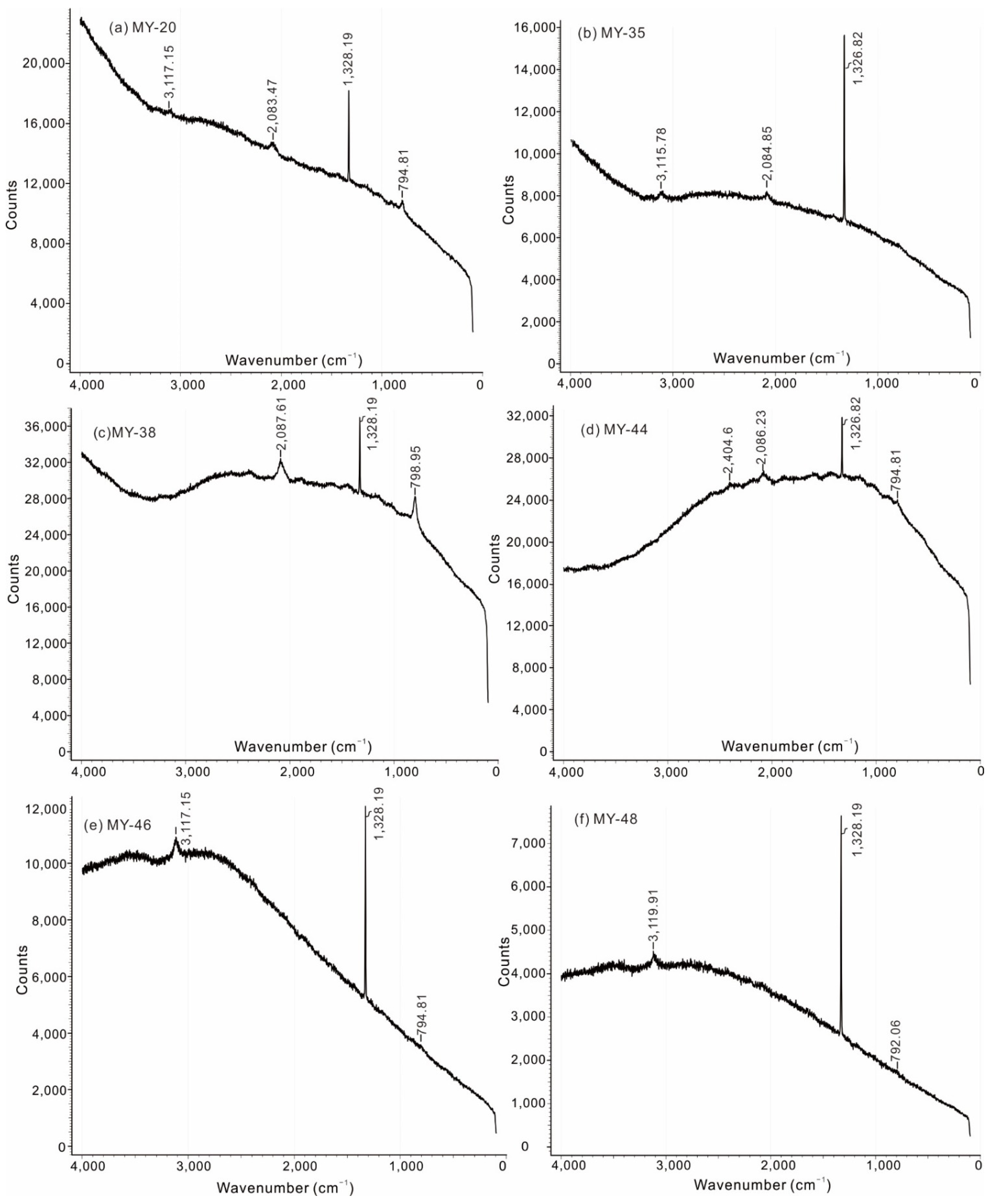
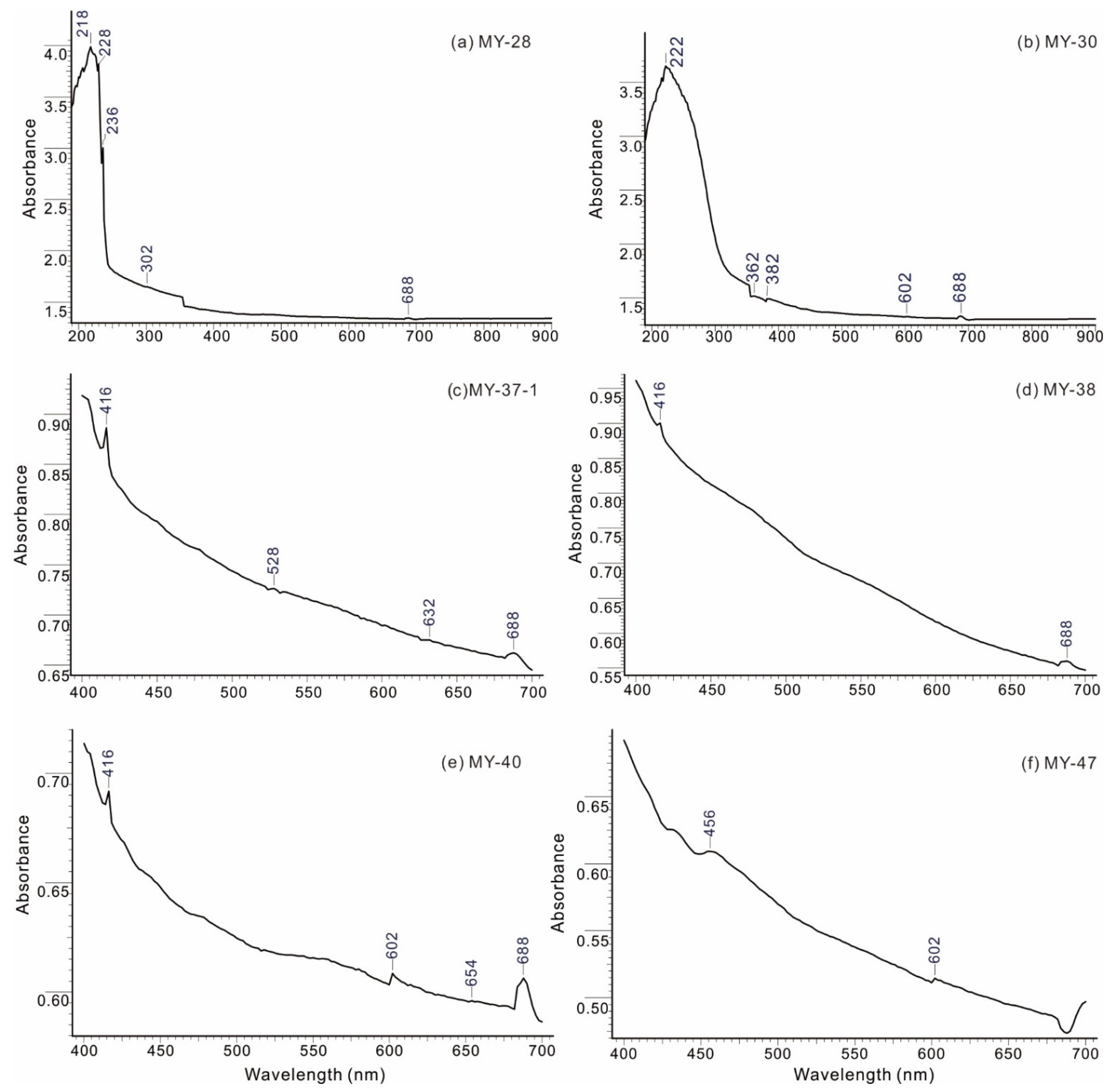
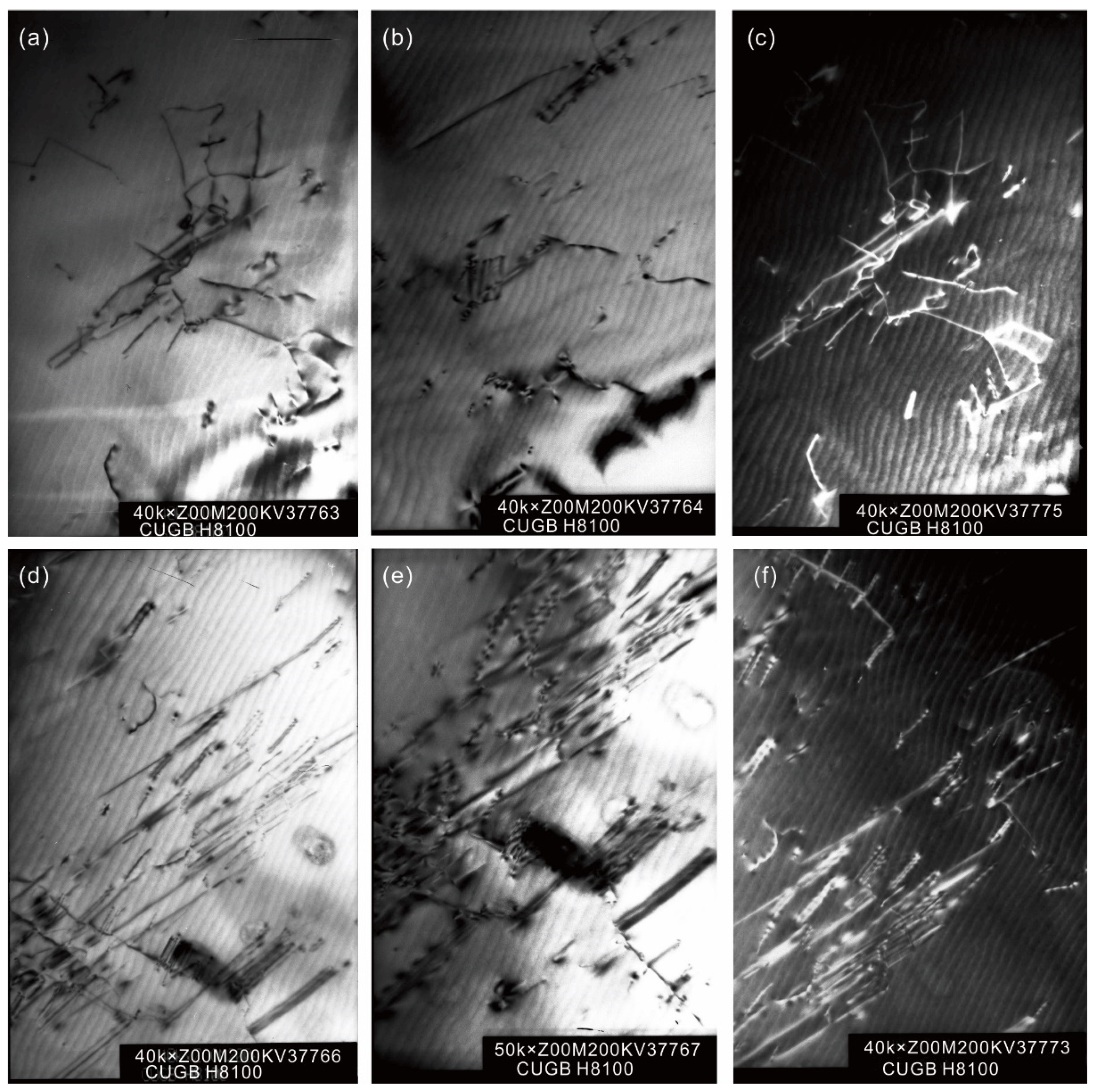
Publisher’s Note: MDPI stays neutral with regard to jurisdictional claims in published maps and institutional affiliations. |
© 2022 by the authors. Licensee MDPI, Basel, Switzerland. This article is an open access article distributed under the terms and conditions of the Creative Commons Attribution (CC BY) license (https://creativecommons.org/licenses/by/4.0/).
Share and Cite
Wu, G.-C.; Yu, X.-Y.; Liu, F.; Li, H.-B.; Long, Z.-Y.; Wang, H. Color Genesis of Brown Diamond from the Mengyin Kimberlite, China. Crystals 2022, 12, 449. https://doi.org/10.3390/cryst12040449
Wu G-C, Yu X-Y, Liu F, Li H-B, Long Z-Y, Wang H. Color Genesis of Brown Diamond from the Mengyin Kimberlite, China. Crystals. 2022; 12(4):449. https://doi.org/10.3390/cryst12040449
Chicago/Turabian StyleWu, Gai-Chao, Xiao-Yan Yu, Fei Liu, Hai-Bo Li, Zheng-Yu Long, and Hui Wang. 2022. "Color Genesis of Brown Diamond from the Mengyin Kimberlite, China" Crystals 12, no. 4: 449. https://doi.org/10.3390/cryst12040449
APA StyleWu, G.-C., Yu, X.-Y., Liu, F., Li, H.-B., Long, Z.-Y., & Wang, H. (2022). Color Genesis of Brown Diamond from the Mengyin Kimberlite, China. Crystals, 12(4), 449. https://doi.org/10.3390/cryst12040449





